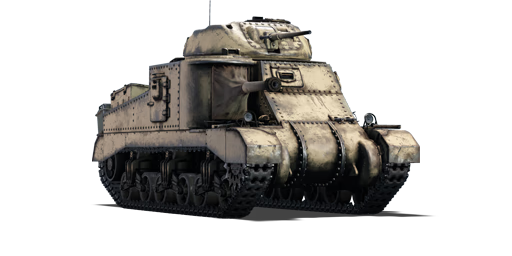




Following the defeat in France, the British military was left in a state of equipment shortage and were in need of American equipment to recover from their losses. The premier American medium tank of the time was the M3 medium, however the British sought for modifications to refit the tanks to better suit British needs as well as build from their existing armour experiences. This led to a much larger turret bing developed by Rock Island Arsenal for the British military, with the new turret capable of housing a radio and doing away with the machine gun cupola. In order to distinguish this modified M3 from the regular M3 mediums being purchased from the United States, the modified M3 was given the nickname "Grant" after Ulysses Grant, the 18th President of the United States and a general who commanded the Union Army during the Civil War. The Grants served within the British and Commonwealth military forces, serving both in the European and Pacific Theater.
Introduced in along with the initial American ground tree in Update 1.45 "Steel Generals" as a bundle vehicle, the Grant shared many similarities with the M3 Lee. The redesigned turret brings protection benefits, with the turret front armour being overall thicker than on the M3 Lee. The removal of the machine gun cupola also removes another weak point to prevent enemies from incapacitating the turret crew. Due to the presence of two cannons, this tank is an excellent multi-role vehicle. The Grant can be played it as a brawler combining the agile 37 mm gun with the high damage of the 75 mm gun, but don't get too close, in fact, the turreted gun has a bad depression and, combined with the high profile, tends to make close tanks difficult to hit. Note that the different guns can be assigned different keys to be separately used, so it is possible to select the 75 mm as a primary weapon, allowing the optics to accommodate the 75 mm shells (and not from the point of view of the 37 mm gun) and use the bullet drop indicator in arcade battles. Finally, despite the awkward position of the 75 mm in the hull, it benefits from a stabilization that would allow faster target acquisition when moving in slow speed or coming to a stop.
Although starting as a bundle vehicle, it was later removed from the store. It was reintroduced for War Thunder's 6th Anniversary as a premium purchasable for Golden Eagles and was made available in the Warbonds shop during Seasons IV and IX of the Battle Pass.
| Ammunition | Type | Armor penetration (mm) at a distance: | |||||
|---|---|---|---|---|---|---|---|
| 10 m | 100 m | 500 m | 1000 m | 1500 m | 2000 m | ||
| AP | 84 | 82 | 72 | 62 | 53 | 46 | |
| HE | 10 | 10 | 10 | 10 | 10 | 10 | |
| APCBC | 97 | 95 | 87 | 78 | 70 | 63 | |
| Smoke | 3 | 3 | 3 | 3 | 3 | 3 | |
| Ammunition | Type | Armor penetration (mm) at a distance: | |||||
|---|---|---|---|---|---|---|---|
| 10 m | 100 m | 500 m | 1000 m | 1500 m | 2000 m | ||
| AP | 79 | 76 | 65 | 54 | 45 | 37 | |
| APCBC | 87 | 84 | 73 | 60 | 50 | 41 | |
| Belt | Belt filling | Armor penetration (mm) at a distance: | |||||
|---|---|---|---|---|---|---|---|
| 10 m | 100 m | 500 m | 1000 m | 1500 m | 2000 m | ||
| AP/T | 13 | 12 | 7 | 3 | 2 | 0 | |







 2 x (35 / 40 / 45) %
2 x (35 / 40 / 45) % 
 2 x 112 %
2 x 112 % 

Mobility | |
|---|---|
Protection |
|---|
Firepower | |
|---|---|